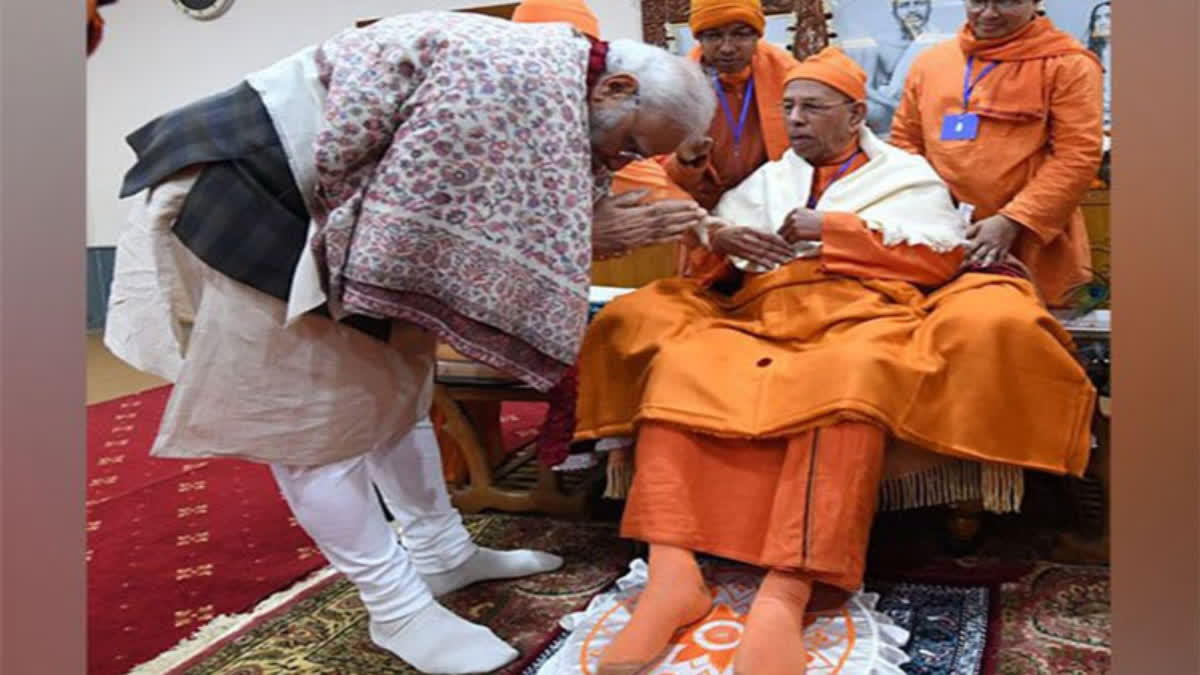Kolkata: Ramakrishna Mission president Swami Smaranananda died on Tuesday night due to age-related ailments, doctors said. Swami Smaranananda, 94, was the 16th president of Ramakrishna Mission, which was founded by Swami Vivekananda.
"Srimat Swami Smarananandaji Maharaj, most revered President Maharaj of the Ramakrishna Math & Ramakrishna Mission attained Mahasamadhi today at 8.14 pm," said a statement issued by the organisation.
The monk was admitted to the Ramakrishna Mission Seva Pratishthan in Kolkata on January 29 with an existing urinary tract infection. He later developed respiratory failure for which he was put on a ventilator on March 3, doctors said.
Prime Minister Narendra Modi and West Bengal CM Mamata Banerjee paid rich tributes to Swami Smaranananda. In a post on X, PM Modi said, "He left an indelible mark on countless hearts and minds. His compassion and wisdom will continue to inspire generations."
"I had a very close relationship with him over the years. I recall my visit to Belur Math in 2020 when I interacted with him. A few weeks ago in Kolkata, I had also visited the hospital and enquired about his health," he added.
The chief minister said the monk would remain the source of solace for millions of devotees across the globe. "This great monk during his lifetime has given spiritual leadership to the world order of the Ramakrishnaites and remains the source of solace for millions of devotees across the globe," she said.
The Ramakrishna Mission said that the cremation will take place at its headquarters Belur Math in Howrah at 9 pm on Wednesday. "The gates of Belur Math will remain open all through the night of the March 26 and through the 27 till the last rites are completed," it said.
Early Life & Education
He was born at village Andami in Tanjavur in 1929 and raised by his aunt after the death of his mother at an early age. He graduated with honours from Chennai's secondary school in 1946. His father worked in Nasik, where he went to complete his diploma in Commerce. Later, in 1949, he moved to Mumbai, where he went on to complete his education and take a job.
He was an avid reader, and fond of English literature and books on self-help by Napoleon Hill. He was also inspired by Mahatma Gandhi's ideology of non-violence. He started chanting of 'Sri Rama' as recommended by Gandhi that set the tone for the rest of his life.
Monkhood
In Mumbai, he came in touch with Swami Aparnandaji of Mumbai ashrama. In search of a deep meaning of life, he joined Mumbai ashram as a brahmachari in 1952, when he was 22 years old on the day of Lord Ramakrishna's birthday.
In 1952, Swami Shankaranandaji Maharaj, the seventh president of the Ramakrishna Mission Mumbai gave him diksha. Subsequently, in 1956, he was initiated into Brahmacharya by Swami Sharmanandaji Maharaj and took sannyasa in 1960. He immersed himself in many activities of the Mumbai Ashram and also took part in distributing relief materials during drought in the Aurangabad area.
Journey as a monk in Belur Math & Contribution
Since the time Swami Smaranananda first visited the Belur Math in 1954 with Swami Sambuddhanandaji, who was the Head of the Mumbai Ashram at the time, he dedicated his life to the cause of the world famous spiritual organisation.
He also was a part of the centennial celebrations of Holy Mother and consort of Sri Ramakrishna Sarada Devi to commemorate her birth and the consecration of her temple at Jayrambati in West Bengal during this time.
In 1958, he was moved to the Advaita Ashrama branch in Kolkata. He was sent to Mayavati ashram in 1961 to help with the editing of Prabuddha Bharata. In addition to his assignment, he was very interested in the dairy, farming, and other endeavours of the Mayavati Ashram. Though he mostly remained at the Advaita Ashrama branch in Kolkata, he made multiple trips to Mayavati and spent several days there. Advaita Ashrama was primarily a publishing house, so he worked hard to raise the standard of publications.
In 1976, he took charge as the secretary of the educational complex Ramakrishna Mission Saradapitha, which is located close to Belur Math. The educational and rural welfare efforts of Sarada ashram made significant advancements during his extensive 15-year tenure at the helm.
When disastrous floods struck West Bengal in 1978, he and his monastic helpers began massive relief efforts. In December 1991, he was transferred from Sarada ashram to Ramakrishna Math, Chennai, where he served as head. During his leadership, work began for the construction of presentday Sri Ramakrishna Temple in Chennai.
In 1983, he was designated as a member of the Ramakrishna Mission's governing body and as a trustee of the Ramakrishna Math. He began working for headquarters in April 1995 as an assistant secretary. Two years later, he became the twin organizations' general secretary.
Spearheaded global Ramakrishna Movement
He led the global Ramakrishna Movement as the RKM's general secretary for ten years, until his selection as the organisation's vice-president in May 2007. In his capacity as vice-president and general secretary, he made numerous trips to India and other countries, visiting both affiliated and independent centers as well as math and mission branches. He made an effort to share the teachings of the Vedanta, Sri Ramakrishna, Swami Vivekananda and Sri Sarada Devi with as many people as possible through his several visits. His writings in magazines published by the Ramakrishna Order ignited minds of young monks and devotees. His talks and papers have been complied in books. Musings of a Monk in English and Smriti-Smaran-Anudhyan and Chintan-Manan-Anushilan in Bengali are his famous books.
Read More
- Puri Shankaracharya clarifies decision to skip Ram Mandir inauguration
- Fostering youth empowerment: A driving force for sustainable India
